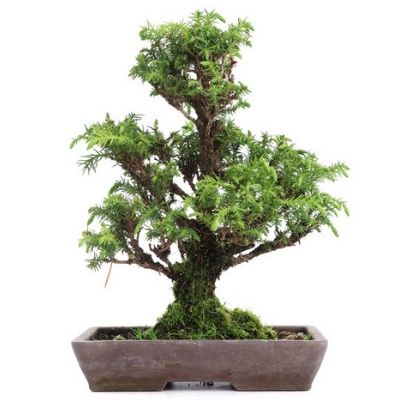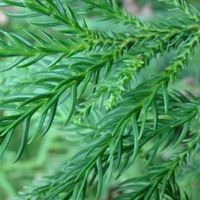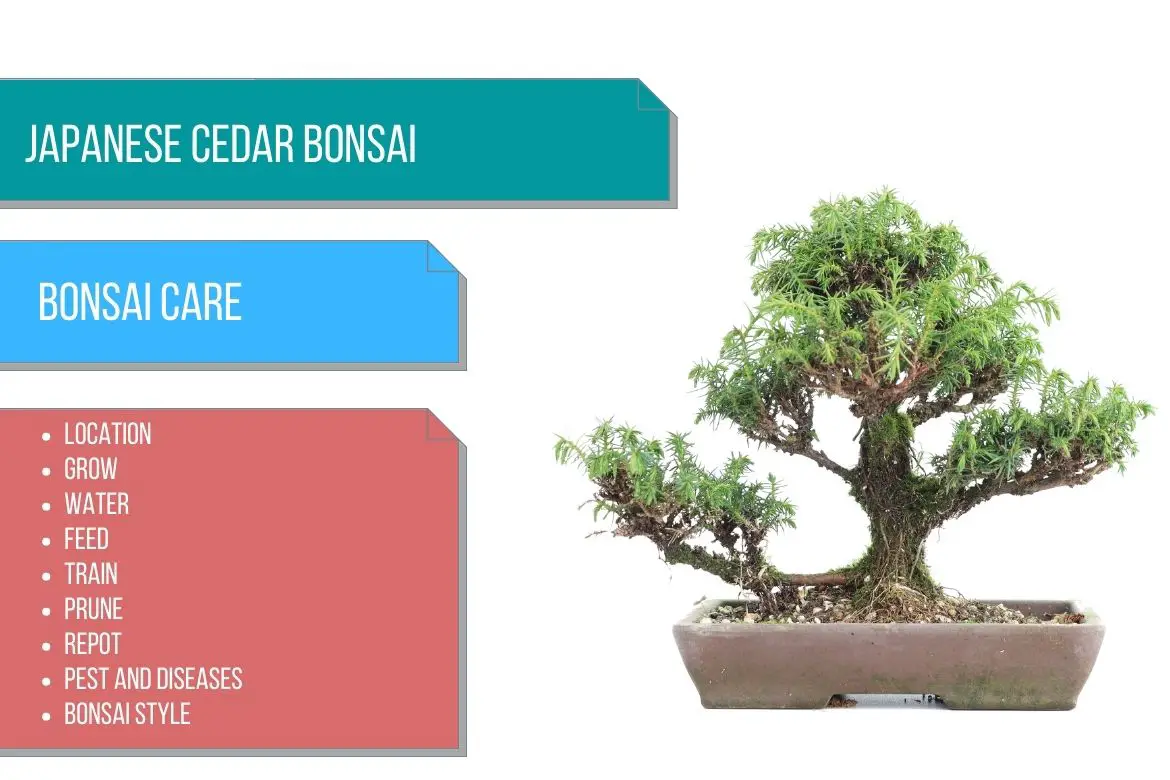
Japanese Cedar
(Cryptomeria japonica)
Country of Origin : China and Japan
Bonsai Styles : Formal upright, group, twin-trunk, clump
Zone : 6 – 9
The Cryptomeria japonica, along with its many cultivars, is another Japanese tree used extensively for bonsai.
An evergreen tree, the Cryptomeria Japonica tree is an elegant, tall tree with a horizontal branch structure that is topped with shallow leaf pads.
When young, the fleshy shoots of Japanese cedar bonsai tree curl downward, unable to support the foliage that is covered in needle-like leaves. Shoots become stiff and upright as they mature.
Growth pattern of Japanese cedar bonsai tree tends to take on a conical shape.
Japanese cedar tree is a tall, straight trunk tree which is grown for timber in Japan. However, it is cultivated as an ornamental tree in Europe and North America.
Japanese cedar is Japan’s answer to California’s massive redwoods. Red-brown, stringy bark covers this tree, and its foliage is rich, blue-green and pointed.
This genus consists of only one species, but it has produced a number of cultivars.
- Cryptomeria japonica Yatsufusa/Yatsubusa– This is a dwarf variety of Cryptomeria japonica bonsai tree. Foliage grows in tightly compact form and has a naturally narrow conical shape.
- Cryptomeria japonica Jindai sugi – Another dwarf variety of Japanese cedar bonsai tree.

The short needles cover the stout green shoots so densely that they are almost completely hidden. Branches and trunks grow adventitious shoots from old internodes and branch intersections.

Japanese cedar bonsai tree fruiting cone.
Best location to keep Japanese Cedar Bonsai
Cryptomeria trees inhabits the lower slopes of mountains in Japan, where the mornings are cloaked in mist, while the afternoons are spent in direct sunlight.
Partially shaded conditions are best for Japanese cedar bonsai tree.
However, If you plan to keep the Cryptomeria japonica bonsai tree out in full sun the whole day, make sure you mist the bonsai tree 2-3 times a day. Also, ensure that the soil in the bonsai pot doesn’t dry out.
A temperature range of 25 – 90 °F ( -3 to 32 °C) is ideal for the Japanese cedar bonsai tree. It is tolerant of normal temperate or subtropical summers.
The foliage will turn brown during prolonged periods of freezing temperatures. However, the green color of the foliage will come back in spring. To avoid this you can move the Japanese cedar bonsai tree to a frost free shed.
During brief periods of freezing, they can be left outside, but prolonged or heavy frosts should be avoided.
Do not expose the Japanese cedar bonsai tree to cold winds.
When protected from wind and their roots are not flooded, cryptomerias japonica can survive subzero temperatures. However, during such conditions, leaves may temporarily take on a bronze hue or a reddish tinge.
Propagation of Japanese Cedar
Japanese cedar tree can be propagated by using softwood cuttings in summer season.
Watering Japanese Cedar Bonsai
In order for Japanese cedar bonsai tree to grow well, they require a lot of water. If not watered appropriately, the branches might die-back.
In summers, water the bonsai tree generously, as the these trees love a moist root. However, do not over saturate the bonsai soil.
Along with watering in summers, also spray mist on the tree at least once a day. Misting the tree will help in increasing the humidity around the Japanese cedar bonsai tree.
The soil should only be just moistened in winter. Water the bonsai tree when the bonsai soil appears dry.
Do not water in frosty weather.
Wiring Japanese Cedar Bonsai
Wiring of Japanese cedar bonsai tree can be done in early summer or spring.
Make sure not to trap foliage under the wire when wiring cryptomerias japonica bonsai tree.
Wires should be removed if they appear to be too tight on the branches, so that you can avoid markings on the branches.
Pruning Japanese Cedar Bonsai
When to prune Japanese Cedar bonsai?
How to prune Japanese Cedar bonsai?
In order to maintain its appearance, cryptomerias japonica bonsai tree needs constant grooming.
Pruning should begin in late spring and continue throughout the growing season. Pruning in spring will promote new growth in the wound area.
Finish pruning in early to mid fall with a light trimming. Make sure that bonsai tree has enough time to heal before the winter season comes.
Ensure that the trunk and main branches are free of unwanted shoots, and prune the shoots that appear bare after losing too many needles.
Also, regularly prune the old twigs so that the younger shoots can grow in enough space and also this will prevent the congestion of the foliage cloud.
Pinching Japanese Cedar Bonsai
Pinching of Japanese cedar bonsai tree can be a time consuming task. All new shoots should be pinched off while still soft and with pale green needles.
During the growing season, pinch back new shoots when they are about 1⁄2 inch (12 mm or 1.2 cm) long.
You can perform pinching every week through out the growing season.
Repotting Japanese Cedar Bonsai
When to repot Japanese Cedar bonsai?
Repot younger specimen of Japanese Cedar bonsai tree every 2 years.
Older specimen of Japanese Cedar bonsai tree can be repotted in 5 years.
Mid spring is a good time to repot Japanese Cedar bonsai tree .
Repotting depends on the root development of the bonsai tree.
Use a basic soil mix or mix.
OR
You can also use equal parts of Akadama and coarse sand, or, equal parts loam and coarse sand.
OR
You can also use equal portions of loam, leaf mold, and sharp sand.
OR
Or you can use 40% grit and 60% organic matter.
Must Read: Bonsai Soil Recipes
Must read : Choosing the right bonsai container
Feeding Japanese Cedar Bonsai
Apply a balanced feed from spring until late summer.
Follow this by applying a nitrogen free feed in early fall.
Midwinter is the perfect time to feed your plants organically to nourish spring growth.
Diseases and pest of Japanese Cedar Bonsai
The dense foliage of the Japanese cedar bonsai tree is the preferred home for spider mites. If not treated in time, spider mites will feed on the sap of the tree from base of the leaves and the fine shoots. Spider mites can cause the affected area to tunr brown or even cause die-back.
Mealy bugs and scaled insects are also a common problem.
Japanese Cedar Bonsai can also suffer from gray mold or Mildew if the growing conditions are poor.
Treatment of all these diseases is easy. Constant thinning will help in keeping the infestation of pest to a minimum.
You can also remove the pest by hands.
Monthly application of weak systemic insecticide can be done to prevent these diseases.
Daily spraying the bonsai tree with cold water or a mild jet of water also proves to be helpful in the control of pests. Spraying cold water will not only prevent red mites from attacking but also imitate the mountain conditions the Japanese cedar tree is use to.
Japanese Cedar bonsai care
Japanese cedar bonsai tree require a lot of pruning and grooming to maintain their appearance.
It is crucial to keep the inner branches of the Japanese cedar bonsai tree free from unwanted shoots and debris.
The branches of Japanese cedar bonsai tree are supple and bend easily. However, while bending the branches be careful as they might break if bent too far.
Note: You can wire the branch and bend the branch just a little. Every 3-4 weeks, you can increase the angle of the bend till the desired angle is achieved.
If the branch does break, the branch will be still attached to the tree with a thin strip of bark or wood. In this case, just rejoin the branch and apply cut paste to the area. Then wrap it with raffia.
By doing this, you can recover the broken branch. Make sure that you don’t bend the branch again.
In the time of winter, the branches may turn brown and one might think that the branch is dead. This is normal. The branches will come back to they green color in spring. This change in color in spring is also a signal for repotting.
Cleaning out the dead twigs and debris from the inner section will enable better light and air circulation. This will also prevent the attack of red mites.
What to look for when buying Japanese Cedar Bonsai
Getting untrained nursery material is relatively easy, but good bonsai nurseries are generally the only places to find Cryptomeria japonica bonsai tree.
As fine specimen of Japanese cedar bonsai tree is rare, it tends to be highly prized.
However, medium to small sized dwarf cultivators of Japanese cedar bonsai tree relatively easier to find as they are produced in more quantity in Japan.
Look for a specimen with bright green foliage as it represents good health.
Avoid any bonsai specimen with yellow patches. Also, avoid a bonsai specimen with dry and dead foliage.
Look for a Japanese cedar bonsai tree with an identifiable trunk structure from roots up to the top.

